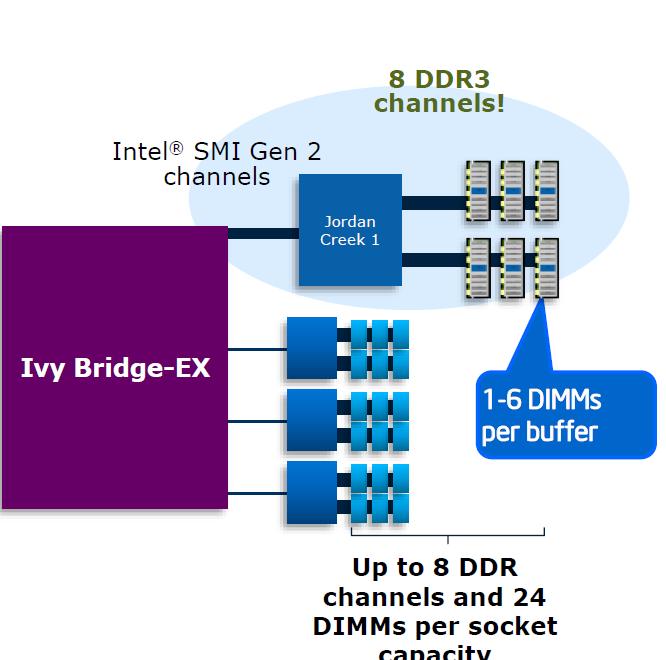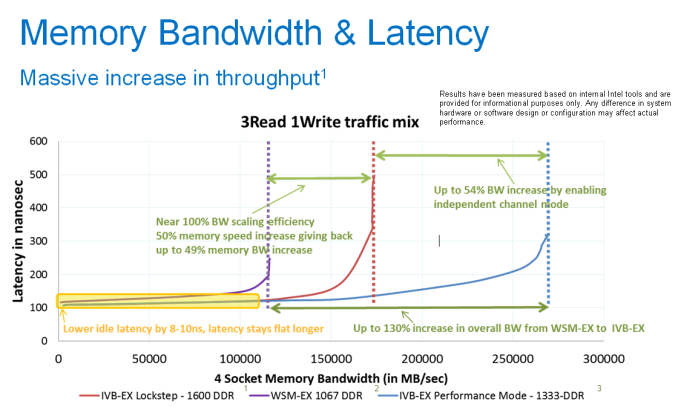The Intel Xeon E7 v2 Review: Quad Socket, Up to 60 Cores/120 Threads
by Johan De Gelas on February 21, 2014 6:00 AM EST- Posted in
- IT Computing
- Intel
- Xeon
- Ivy Bridge EX
- server
- Brickland
Bandwidth Monster
Previous versions of Intel's flagship Xeon always came with very conservative memory configurations as RAM capacity and reliability was the priority. Typically, these systems came with memory extension buffers for increased capacity, but those memory buffers also increase memory latency. As a result, these quad- and octal-socket monsters had a hard time competing with the best dual-Xeon setups in memory intensive applications.
The new Xeon E7 v2 still has plenty of memory buffers (code named "Jordan Creek"), and it now supports three instead of two DIMMs per channel. The memory riser cards with two buffers now support 12 instead of eight DIMMs (Xeon Westmere-EX). Using relatively affordable 32GB DIMMs, this allows you to load a system machine up to 3TB RAM. If you break the bank and use 64GB LRDIMMs, 6TB RAM is possible.
With the previous platform, having eight memory channels only increased capacity and not bandwidth as they ran in lockstep. Each channel delivers half a cache line, then the Jordan Creek buffer combines those halves and sends off the result to the requesting memory controller. The high speed serial interface or scalable memory interconnect (SMI) channels must run at the same speed as the DDR3 channels. With Westmere-EX, this resulted in an SMI running at a maximum of 1066MHz. With the Xeon E7 v2, we get four SMI interconnects running at speeds up to 1600MHz. In lockstep, the system can survive a dual-device error. As result, the RAS (Reliability, Accessibility, Serviceability) is best in Lockstep.
With the Ivy Bridge EX version of the Xeon E7, the channels can also run independently. This mode is called performance mode and each channel can deliver one cache line. To cope with twice the amount of bandwidth, the SMI interconnect must run twice as fast as the memory channels. In this case, the SMI channel can run at 2667 MT/s while the two channels work at 1333 MT/s. That means in theory, the E7 v2 chip could deliver as much as 85GB/s (1333 * 8 channels * 8 bytes per channel) of bandwidth, which is 2.5x more than what the previous platform delivered. The disadvantage is that only a single device error can be corrected—more speed, less RAS.
According to Intel, both latency and bandwidth are improved tremendously compared to the Westmere-EX platform. As a result, the new quad Xeon E7 v2 platform should perform a lot better in memory intensive HPC applications.












125 Comments
View All Comments
TiGr1982 - Friday, February 21, 2014 - link
I think, 6 cores on desktop for $300 will NOT happen this year.Because if it will, then you'll get $300 4 core i7 on mainstream 1150 & $300 6 core i7 on new 2011 simultaneously on the market.
To adjust this, they'll have to sell 1150 4 core i7 for $200-$220, like Core i5 now.
This is not realistic, because that's Intel we're talking about, right?...
dragonsqrrl - Friday, February 21, 2014 - link
That's actually the plan, except it won't be $300. I think the latest leaks suggest that the lowest end Haswell-E SKU will be a 6-core K series at ~$400. The other two price points remain about the same, $600 and $1000 for the 8-core SKU's.TiGr1982 - Saturday, February 22, 2014 - link
To me, seems too good to be true. Will require a major change of mindset inside Intel to start selling 6 core for $400 and lower 8 core for $600 :)(while 8 core XE for $1000 is not surprising at all)
Harry Lloyd - Saturday, February 22, 2014 - link
The thing is LGA2011 mobos are really expensive, so the CPU price does not have to be that high. You can get a good B85 mobo even for less than 100 $, and an LGA2011 mobos start at 250 or even 300 $.I would not pay 300 $ for a mobo, and 400 $ for a 6-core CPU, that would still be ridiculous. I hate this stagnation. The transision from 1-core to 4-core happend really quickly.
MrSpadge - Saturday, February 22, 2014 - link
The smallest 6-core K model has been around 500$ for quite some time, so I see no problem going to 400$ this time. 8 cores for 600$ would indeed be a significant step for some, though.psyq321 - Monday, March 10, 2014 - link
Well, if Intel manages to castrate the HEDT "E" version enough so that it does not pose any threat to their Xeon revenue, price drop might happen.However, one factor not to be underestimated is total available market and how much are target consumers for this kind of hardware willing to pay. I have no data, but for some reason I think only small % of "power users" (>very< power users) need 8 cores today and they would probably be willing to shell out $1000.
Thing is, if you are Intel, you will probably making the calculation: what if we drop the price to, say, $600? Is this going to bring us more customers? Is this going to cannibalize some of, more lucrative, Xeon market?
I suppose if Intel fuses out TSX, VT-D, ECC memory support and, of course, QPI (which is what they do anyway with Sandy-E and Ivy-E HEDT CPUs) the chip would practically be next to useless to most Xeon customers. So the remaining issue is the market.
f0d - Friday, February 21, 2014 - link
i agreei was hoping for 8 core ivy bridge-e chips but had to settle for 6 cores which i can easily use all of
i do a LOT of video encoding using handbrake and that program just loves cores, i easily saturate all 12 threads with my settings in handbrake so i do believe it could use a single socket 8 core well (i have read tests that show handbrake not liking dual/quad socket systems for more cores - but does improve when using lots of cores on a single socket)
MT007 - Friday, February 21, 2014 - link
You have a error on page 8, in your fourth paragraph you have the opteron as 2.4ghz and only with a score of 2481. From your graph it should have been 2.3ghz and 2723?webmastir - Friday, February 21, 2014 - link
They don't tend to fix errors/read comments I don't think.JohanAnandtech - Friday, February 21, 2014 - link
Sure we do :-)